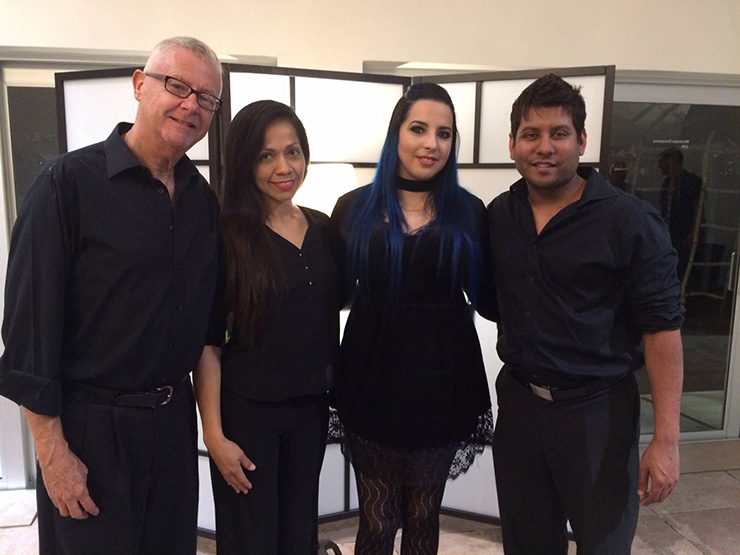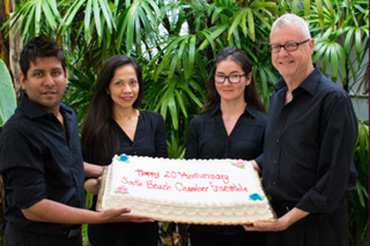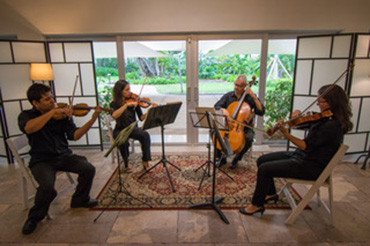
Michael Andrews, Ericmar Perez, Indira Labañino and Tony Seepersad.
Four rock ‘n’ roll musicians working hard as a collective soul, communicating intensely with each other, may have appropriated their DNA from the string quartet – a lead voice, rhythm and bass fleshing out a melody. Arguably, chamber music was the pop music of the Baroque, Classical and Romantic periods, and it’s still attracting audiences and new composers today. Some rock groups have staying power that spans decades. True to form, many string quartets do the same, and the South Beach Chamber Ensemble a fine example.
SBCE wrapped up its 20th anniversary season with a pair of chamber concerts on May 18 and 20 at the Dot Fiftyone Gallery in Miami and Miami Beach Botanical Garden, taking their intimate audience on a “historical cruise down the string quartet river,” from the invention of the quartet by Haydn to a new piece by New World School of the Arts composition student Indira Labanino Leon. Along that premium waterway they served up a musical pastiche from Mozart and Beethoven to Gershwin and Glass.
The string quartet has tested the great composer’s art since the mid-18th century. Though without the breadth of a full orchestra, the form covers every low, mid and high note in the musical vocabulary with the minimum number of voices to present all the dimensions of a full argument or to deposit fine melody into the heart and soul of the listener.
Since Haydn, the string quartet has literally become a rite of passage for any serious composer of classical music. Witness the embarrassment of riches in the 20 short pieces in this evenings program.
A large image painted on the wall of the acoustically alive Fiftyone Gallery, looking like a three-dimensional sculpture in many shades of brown, suggested SBCE’s multi-dimensional program before us, presenting a wildly varied sampler of string quartets, some to tease, some full blown and some insisting that the listener search for more.

The inspired members of SBCE include Tony Seepersad (violin), Ericmar Perez (violin), Elizabeth Oka (viola) and Michael Andrews (cello).
Haydn, who single-handedly invented the string quartet (he wrote 68 of them), profoundly influenced Mozart and Beethoven – The first three pieces in SBCE’s program featuring these musical royals. Andrews suggested the conditions under which Haydn developed the hallowed musical form: Isolated as Kapellmeister in the Court of Esterházy and consequently not living in the musical hubs of Vienna, Prague or London, Haydn was “forced to be original.”
Opening with the 1st movement of Haydn’s lively Op. 76, the collective SBCE voices took their individual moments with this wonderful interplay of louds and softs. The 1st movement from the teenage Mozart’s K 157 (from his six Milanese Quartets dedicated to Haydn) was a pleasant melody cloaked in a polite scamper, the foursome catching each other’s eye and obviously having fun. Beethoven, a pupil of Haydn, elevated the quartet to a higher level, his Op. 18 1st movement sounding of a full orchestra, rich, with intricate harmonies.
Aware of his imminent death and as a testament to it, Schubert composed his String Quartet in D minor (Death and the Maiden), the theme of death palpable in all four of its movements. The well connected SBCE players effectively wrought the anxiety out of the 1st movement, creating a sense of urgency as if in a hurry to achieve something yet unachieved.
Seepersad was high flying in the opening movement of the Mendelssohn Op. 13, the focused motif bouncing effortlessly from player to player. The energetic foursome adeptly handled the many pleasing motifs and tempo shifts of Brahms familiar Hungarian Dance #5. Andrews rendered the beautiful melody from the 3rd movement of Borodin’s String Quartet No. 2, the rich tone from the belly of his cello passing to Seepersad’s violin, bringing all the sweetness of the acquainted theme to bare. The ensemble played mightily on the final movement of Dvořák’s Op. 96 (American Quartet), the communication strong between the players, Andrews, Seepersad and Oka sharing the driving solos.
Props to Perez for adding richness and strong harmonies in the Haydn, Mozart, Beethoven and Schubert, and to Oka with solos in the Schubert and Mendelssohn.
Moving into contemporary territory, the middle section of Amy Beach’s “String Quartet in One Movement,” a slow meditative piece, both dissonant and melodic, brought a clarion call played powerfully by Oka, Seepersad later emerging with the movement’s lovely melody. A percussive 2nd movement from Ravel’s String Quartet in F major was a pizzicato fest, each voice taking a turn plucking with abandon. The foursome lit into Shostakovich’s Op. 110, a serious scurry suggesting his reluctance to join the communist party and dealing with a recent diagnosis of ALS. The ensemble was wound up tightly and biting at their strings as they suffused the audience with the intense music of Shostakovich’s 2nd movement, harsh words for the composer to speak and the listener to hear.
Elgar composed “Enigma Variations,” a seminal orchestral work paying homage to important people and events in his life. The recognizable “Nimrod” (Variation IX) was co-opted into a string quartet. Seepersad acquitted the somber theme well, effectually rising with the introspective melody as it settled into a quiet hush.
A pair of Latin composers provided their work, Seepersad suggesting that the 3rd movement of Villa-Lobos’s String Quartet No. 5 should be considered “the new wedding march.” Expressing a variety of musical influences, the lower voices with the melody moved into a little light Latin swing midway and ended up with a folksy conclusion. A crowd fave was the 2nd movement of Orbon’s String Quartet, a frenetic opening morphing into a hard-driving dissonant idea, the SBCE players moving as if in a heated conversation, not unlike the sound of our present environment.
The 3rd movement of Webern’s Op. 5, a study in 12-tone technique (all 12 notes of the chromatic scale given equal weight), opened dramatically, the lower voice with an abstract pizzicato with the violin sounding on top.

Perhaps George Gershwin’s first serious piece was “Lullaby for String Quartet,” written when he was a student. This touching piece glimpsed the unknown composer’s inimitable voice, his signature sense of rhythm evident in the work. You could hear the young Gershwin emerging as the ensemble played with a sense of admiration, the sweet swaying melody moving dreamily as the violins developed the calming melody textured with the plucking of the cello.
Philip Glass’s “Company” was expected to be a piece of instrumental music for an adaptation of Samuel Beckett's novella with the same name. SBCE’s interpretation of the repetitive motif of the 2nd movement created a calming effect, and like several of the pieces played this evening, left the audience wanting more.
The solemn opening to South African composer Philip Miller’s “Weighing and Wanting” became a pensive study, Oka handling this assignment with sensitivity.
SBCE ran a composition contest for a new work to be showcased for their 20th anniversary celebration and that honor went to Cuban composer Indira Labañino Leon. The lovely sweet melody opening “Weeping of the Woods” was enriched with a touch of melancholy, the romantic bent morphing into an unexpected ‘metal-esque’ passage, Leon developing those chops from time spent with her band Hipnosis. Andrews managed the metal riff handily, the music blended back into the lush theme, ending with the enthusiastic applauds of the audience.
All four players slapping their instruments percussively with the flat of their hands began Jessie Montgomery’s “Voodoo Dolls.” The group stirred up the hall with a folksy dissonant rhythm, an Asian-esque theme inserted itself in the middle, Seepersad and Perez improvising all along the way. A big sound quieted into a soft stir at the finish, Perez lightly tapping her violin with her fingers as the sound faded.
A standing O was in order for these fierce and accomplished music makers.
When Andrews founded SBCE, he said that he knew nothing about “running a business… I just played the cello and had a great idea – Music in Beautiful Spaces.” He continued, “Music allows us to remember the past and inspire us for the future.”
SBCE did just that.
With always accessible themes, both the unseasoned listener and the marinated aficionado can easily cotton to SBCE’s programs.
For SBCE’s upcoming concerts, go to: http://sobechamberensemble.org




